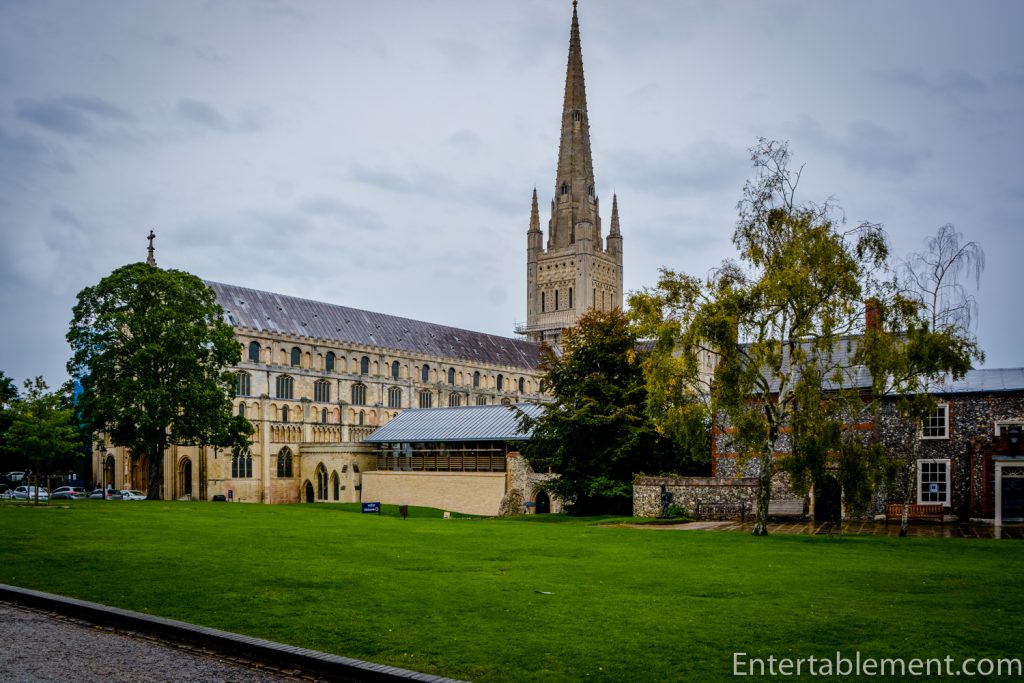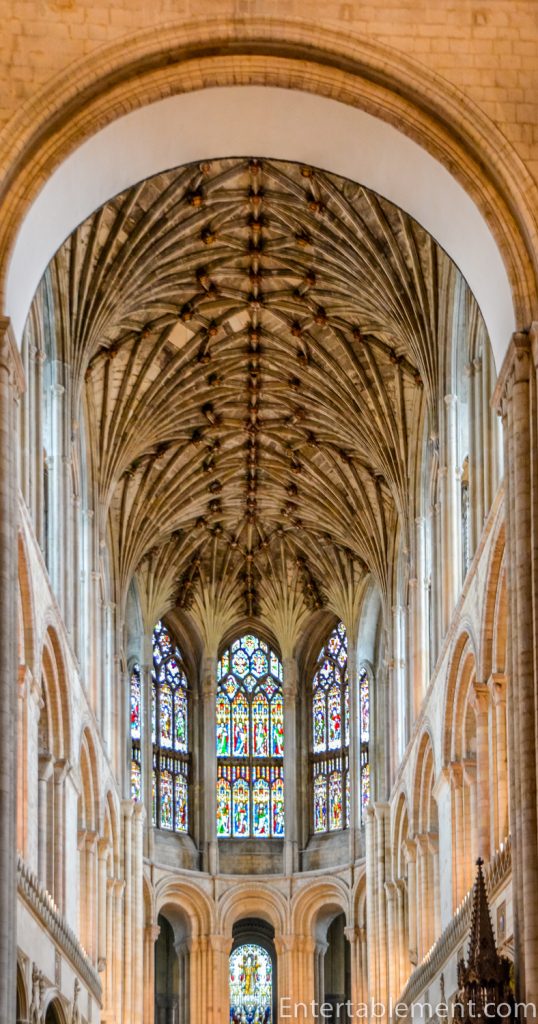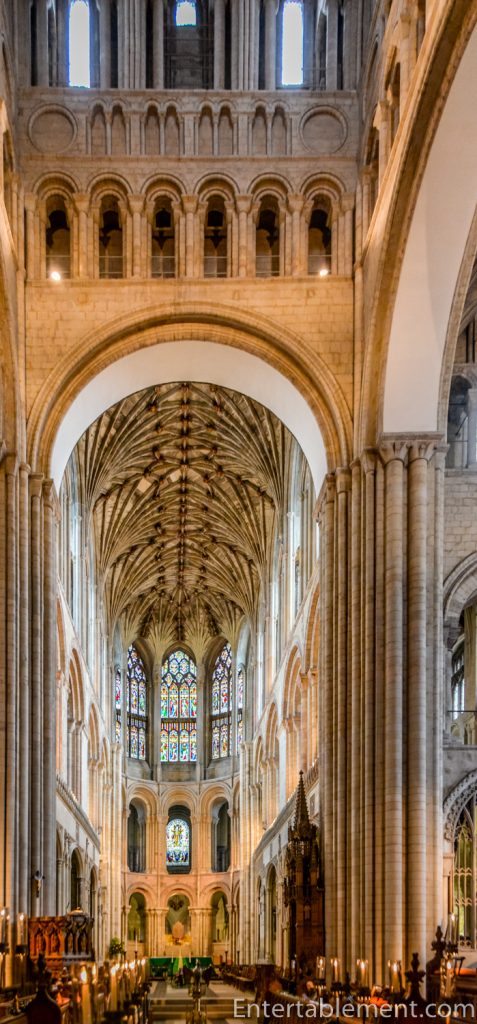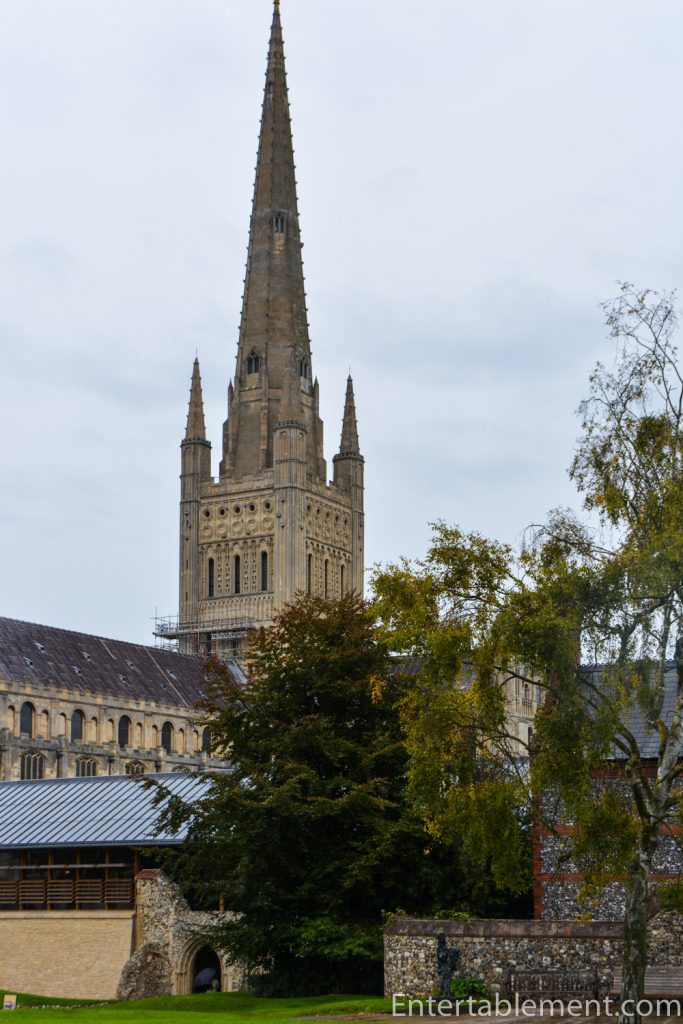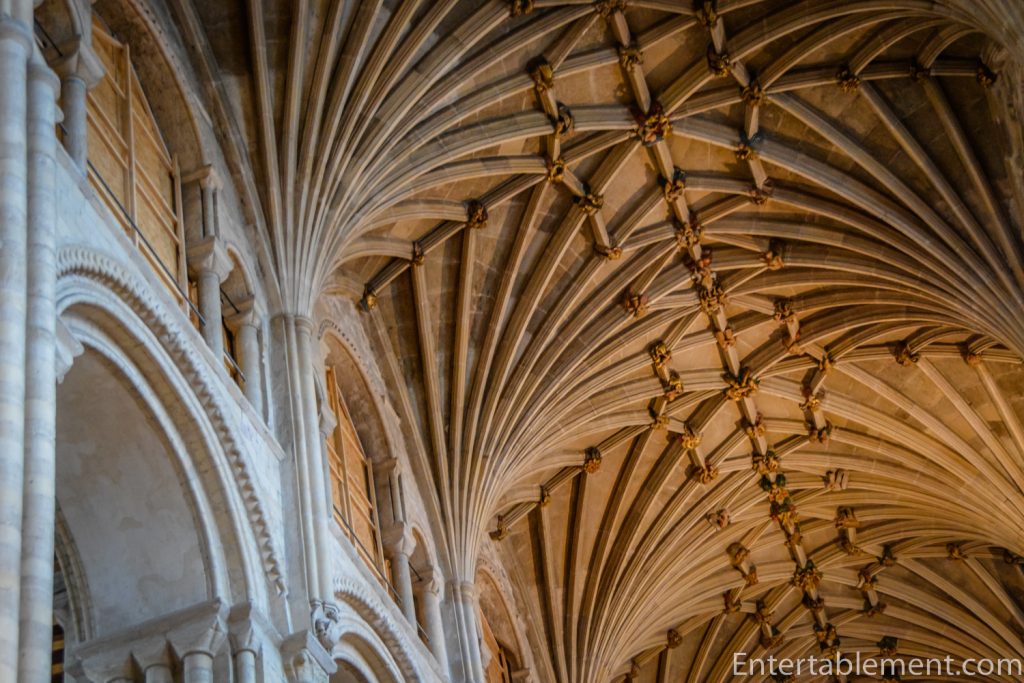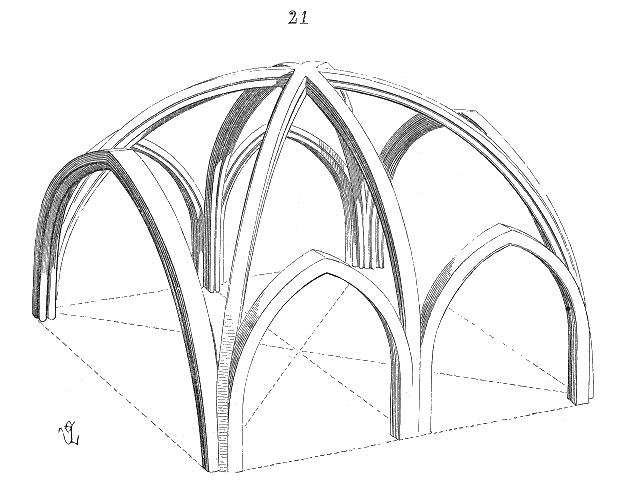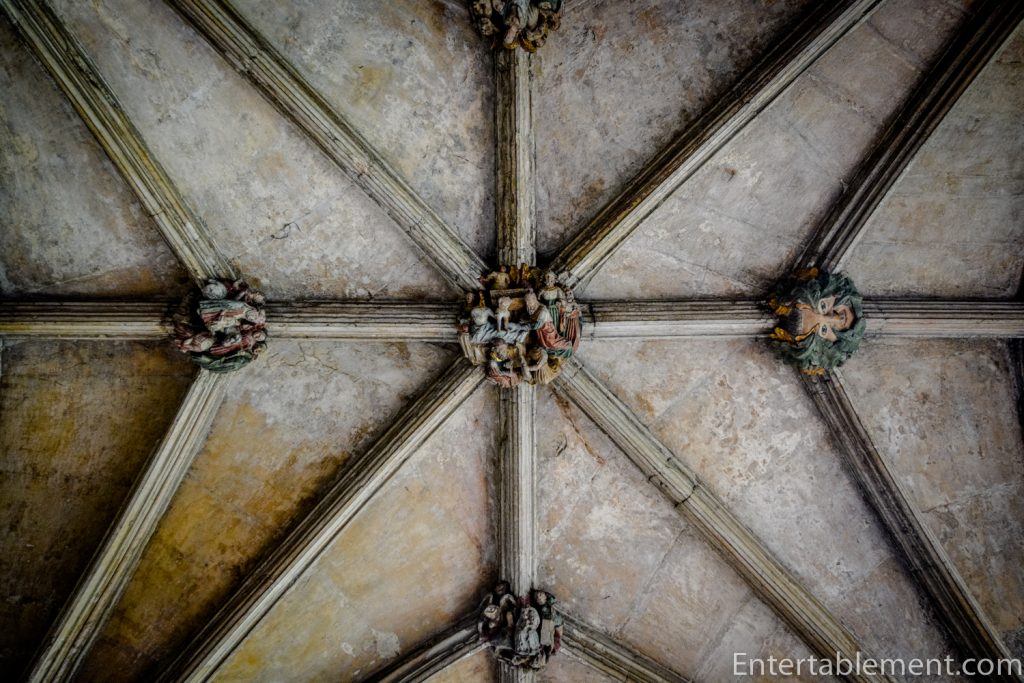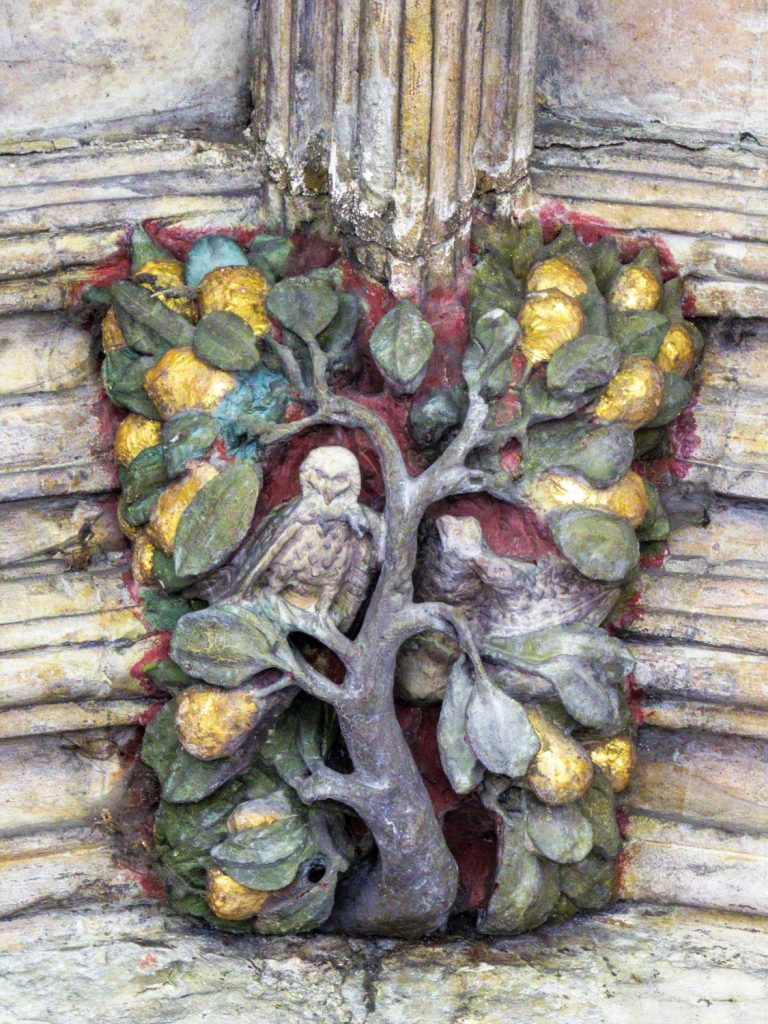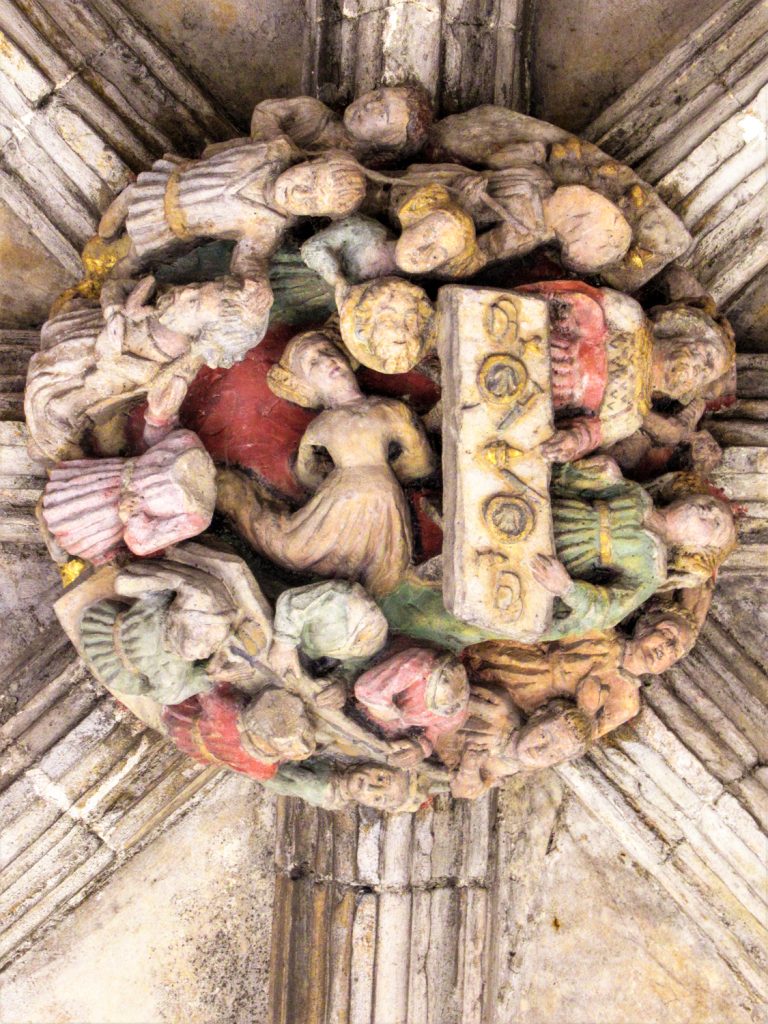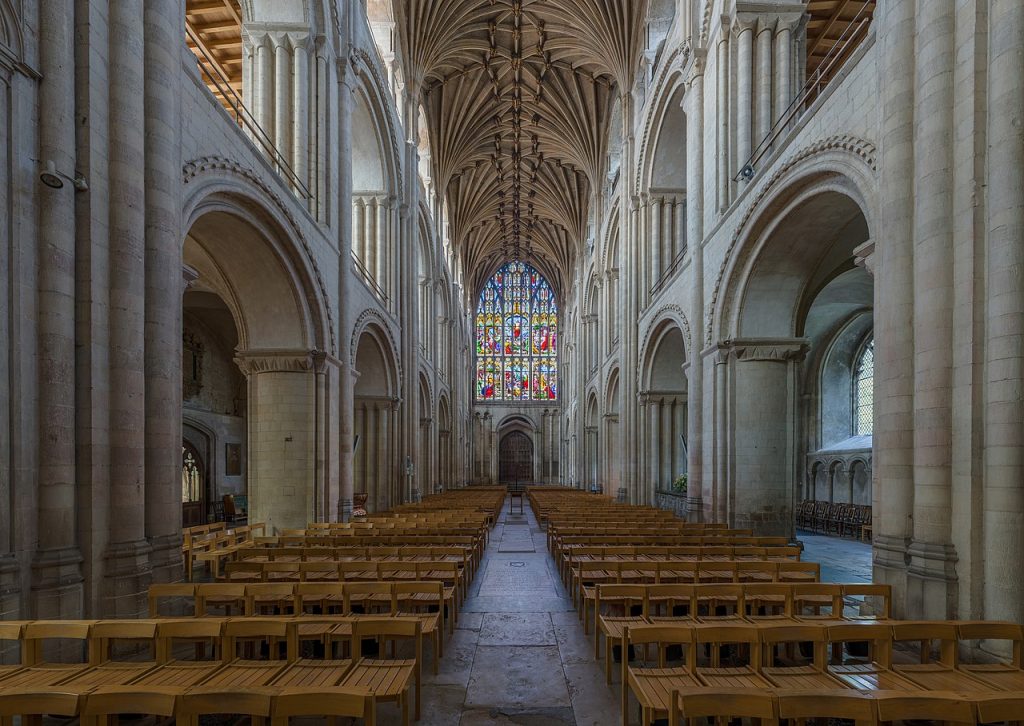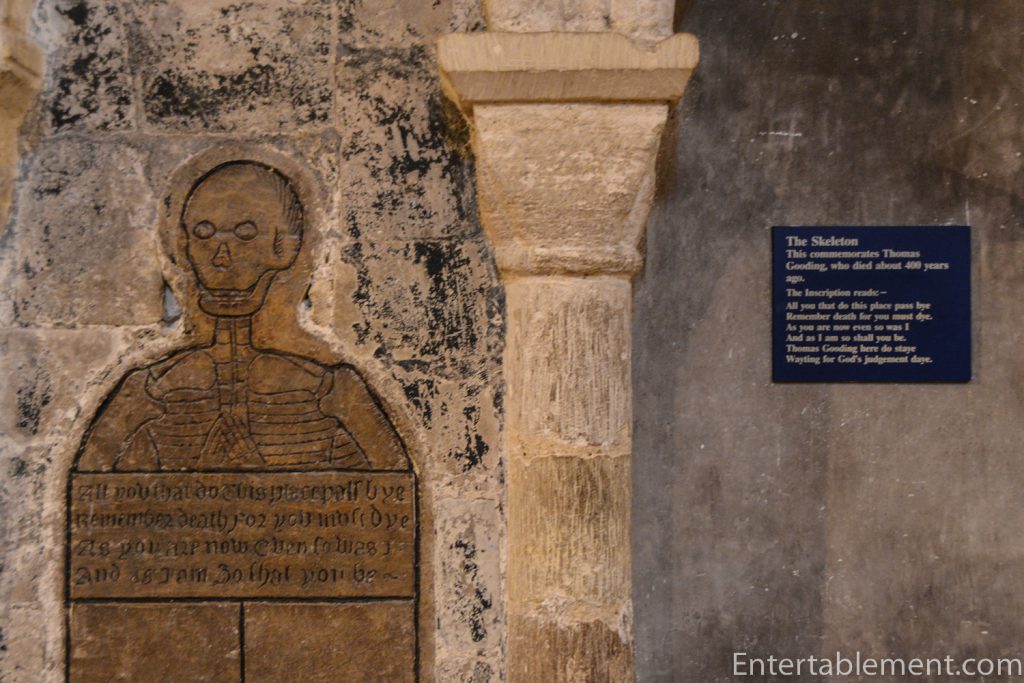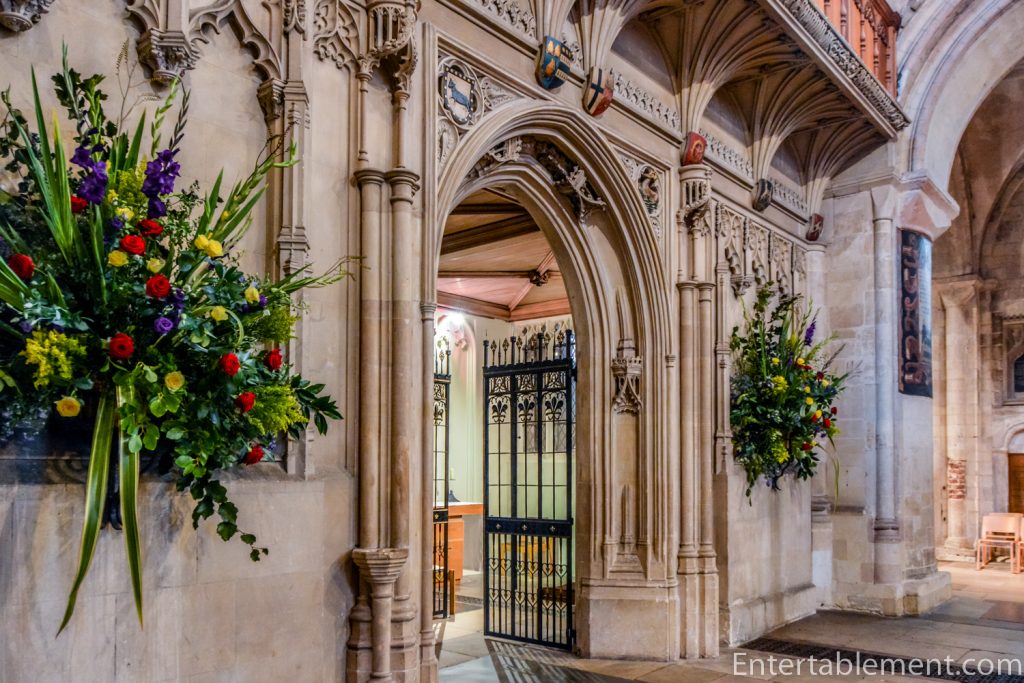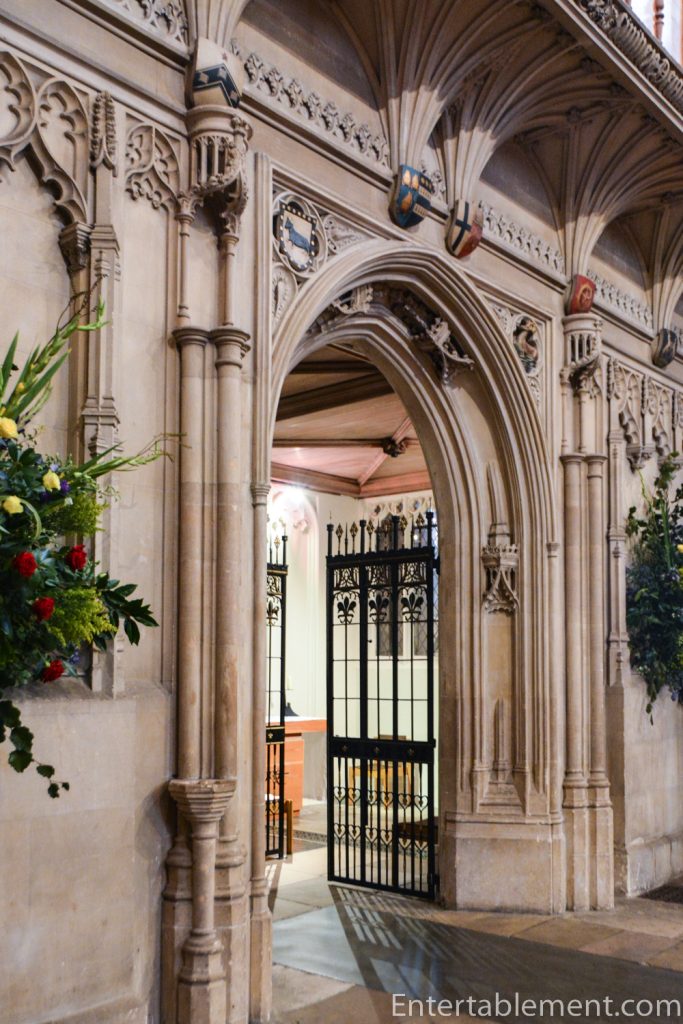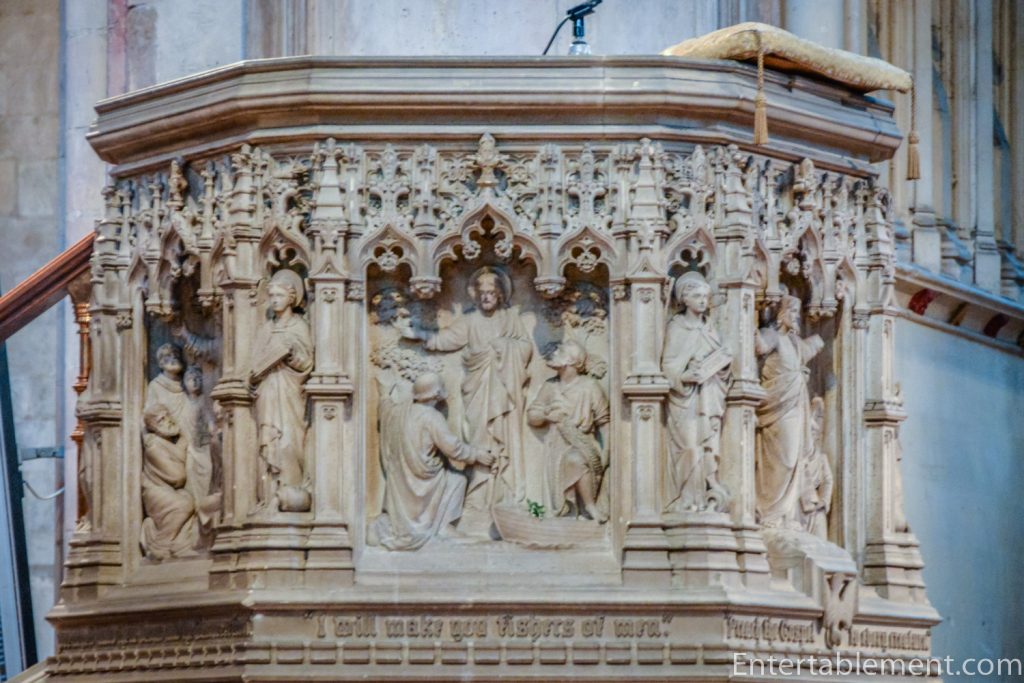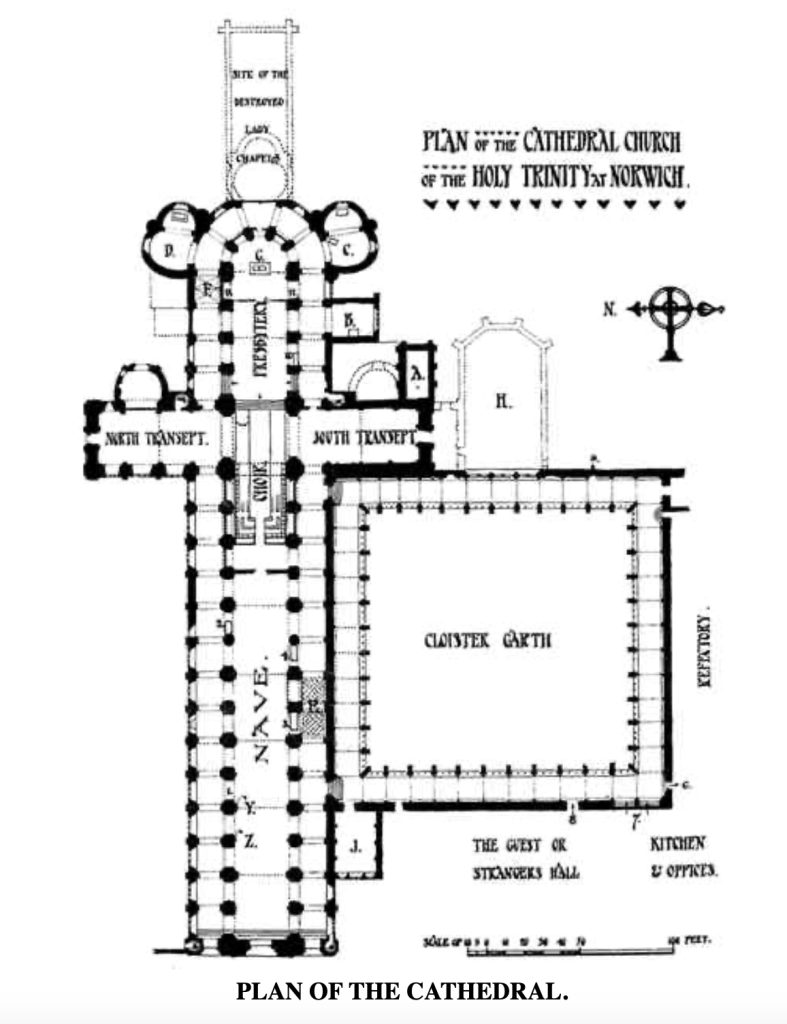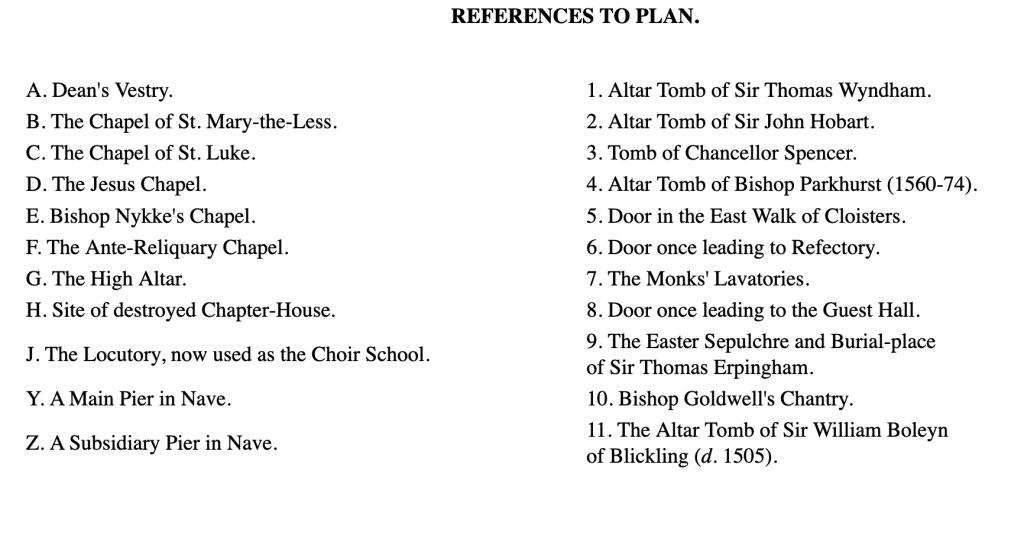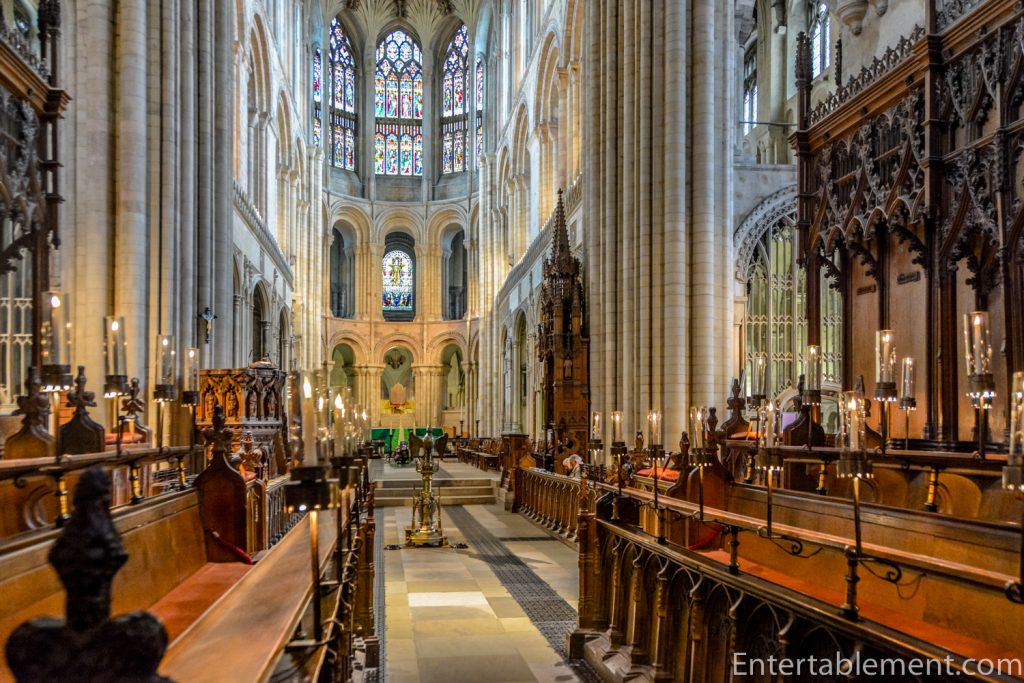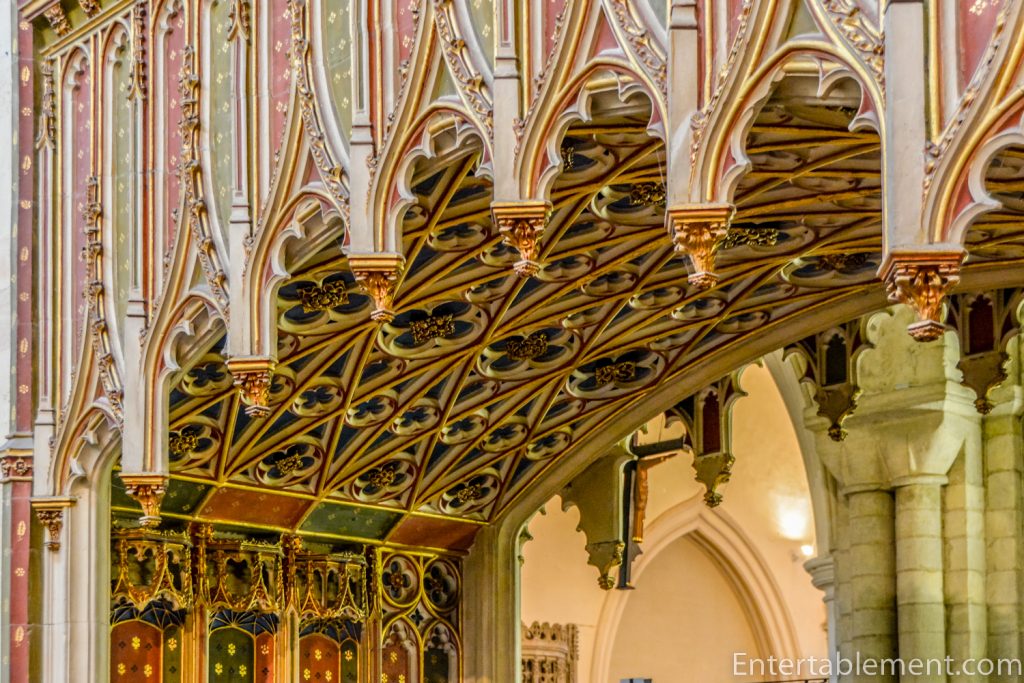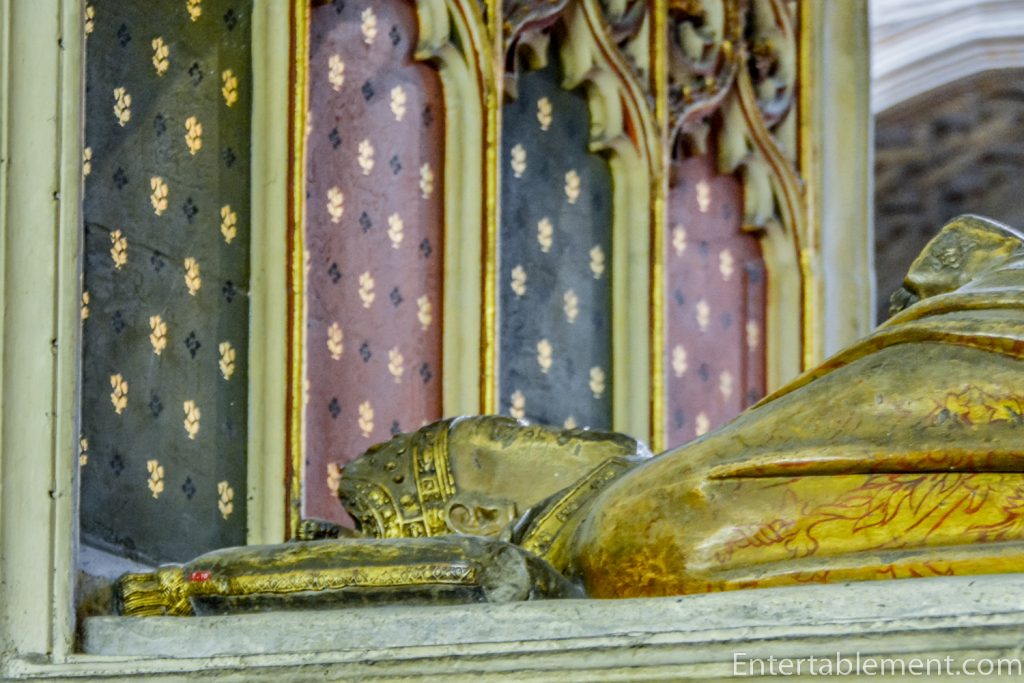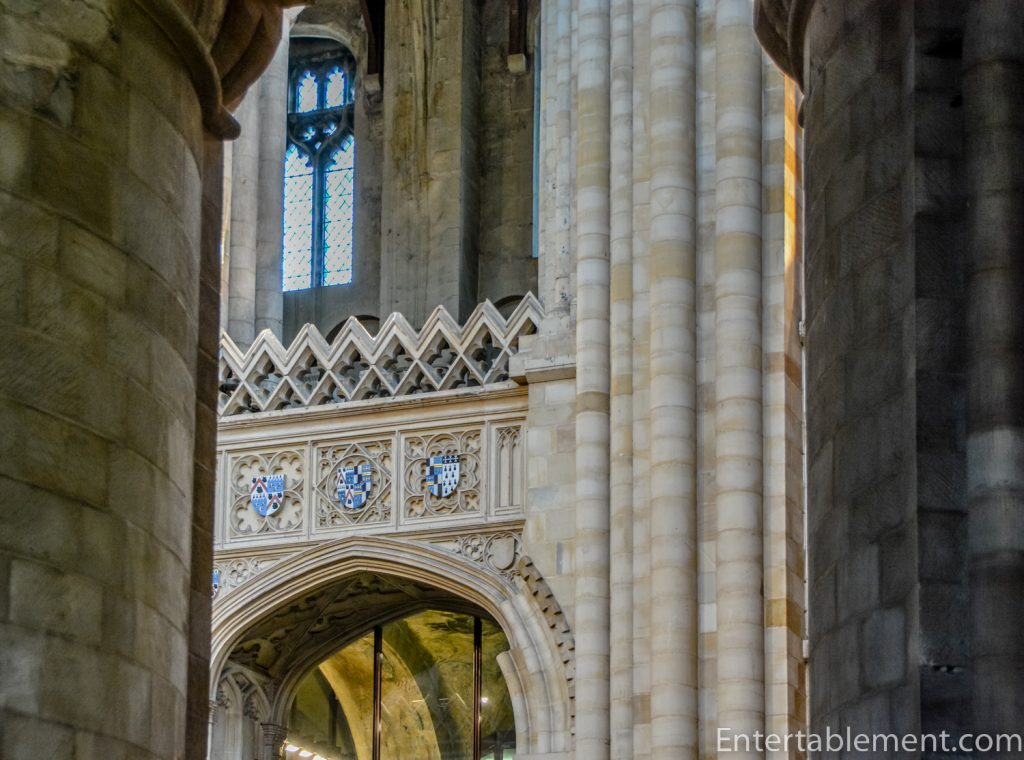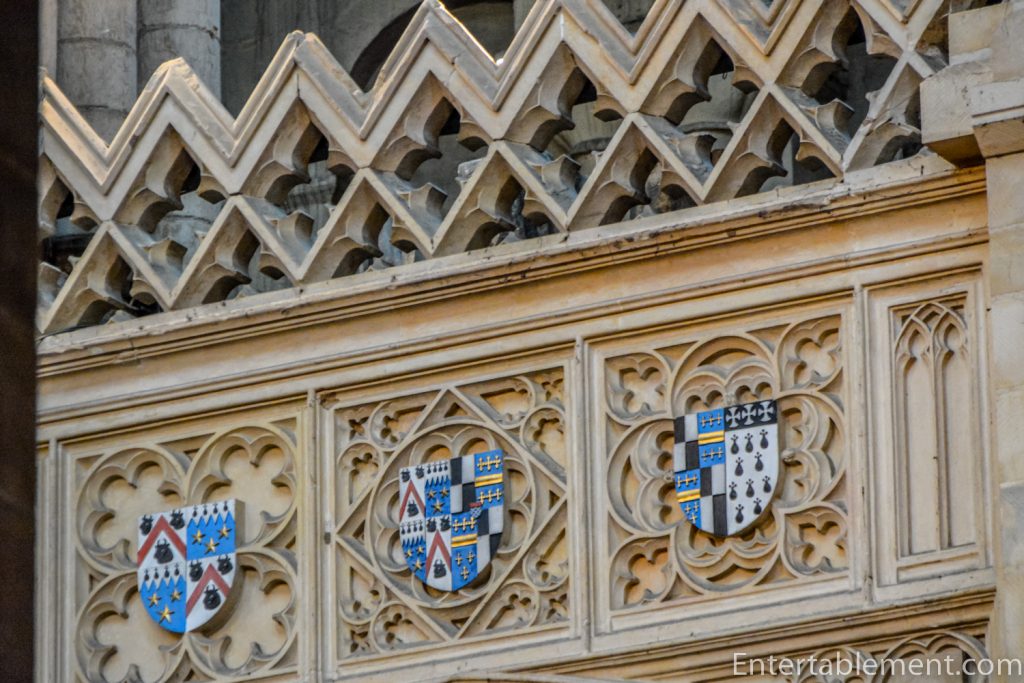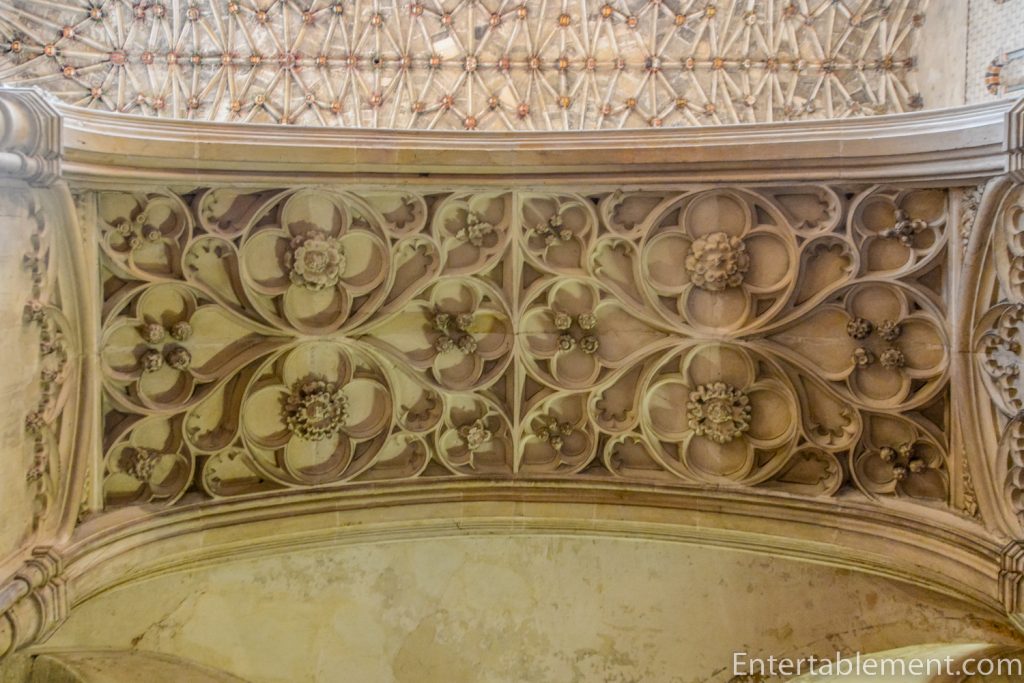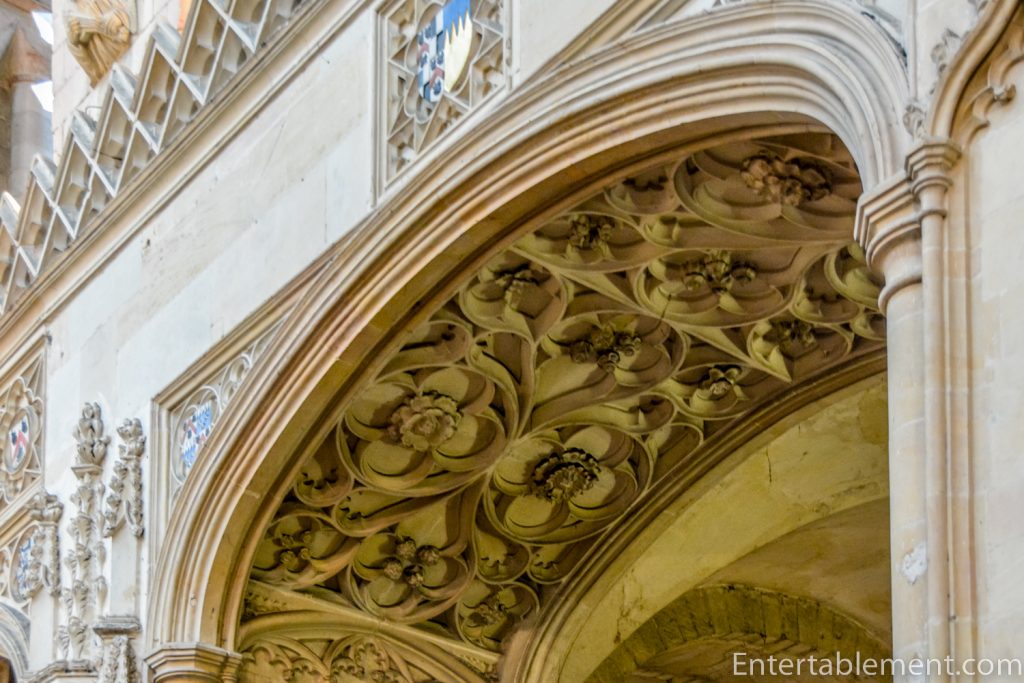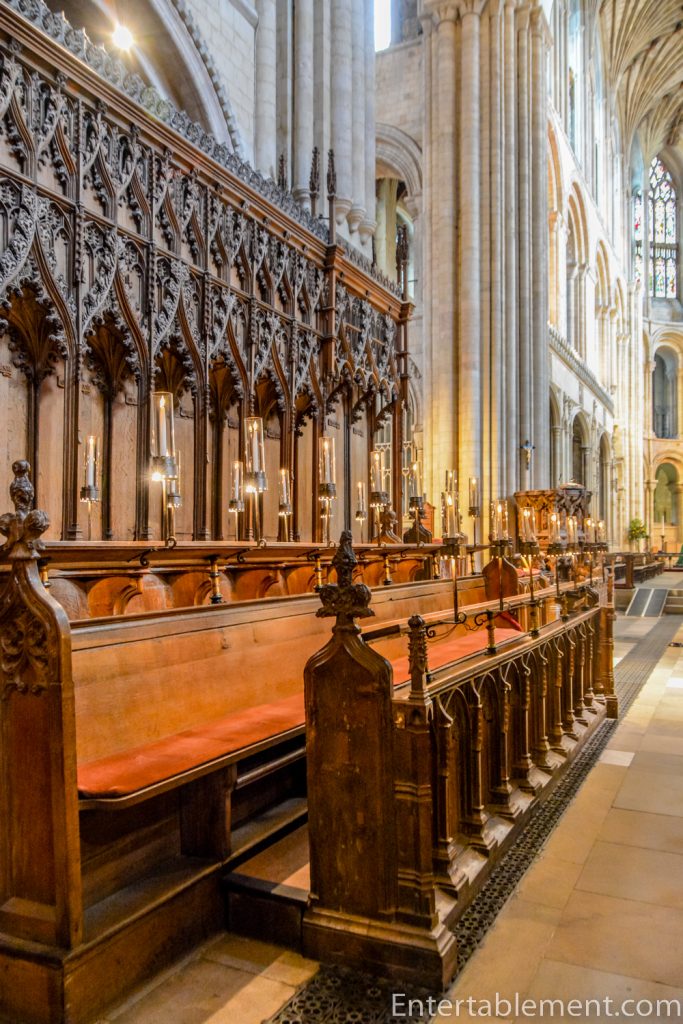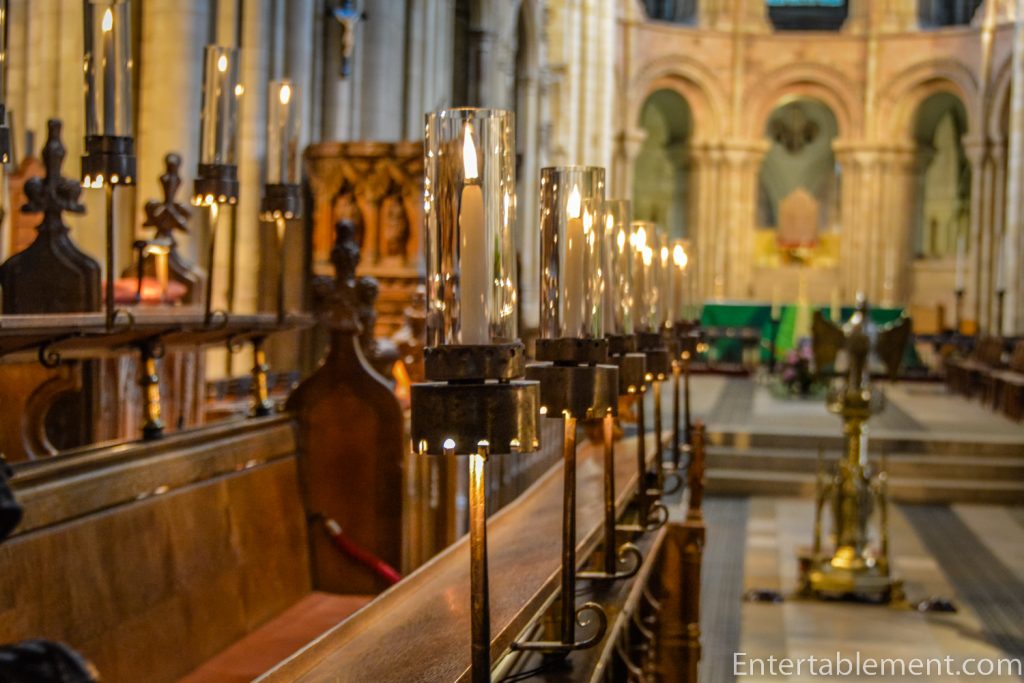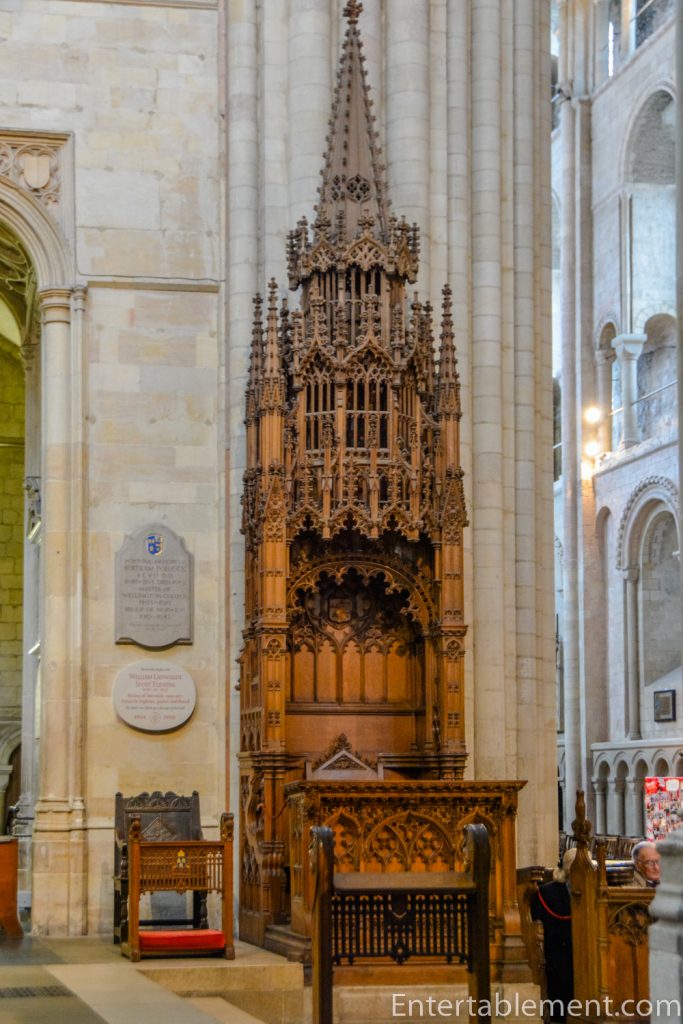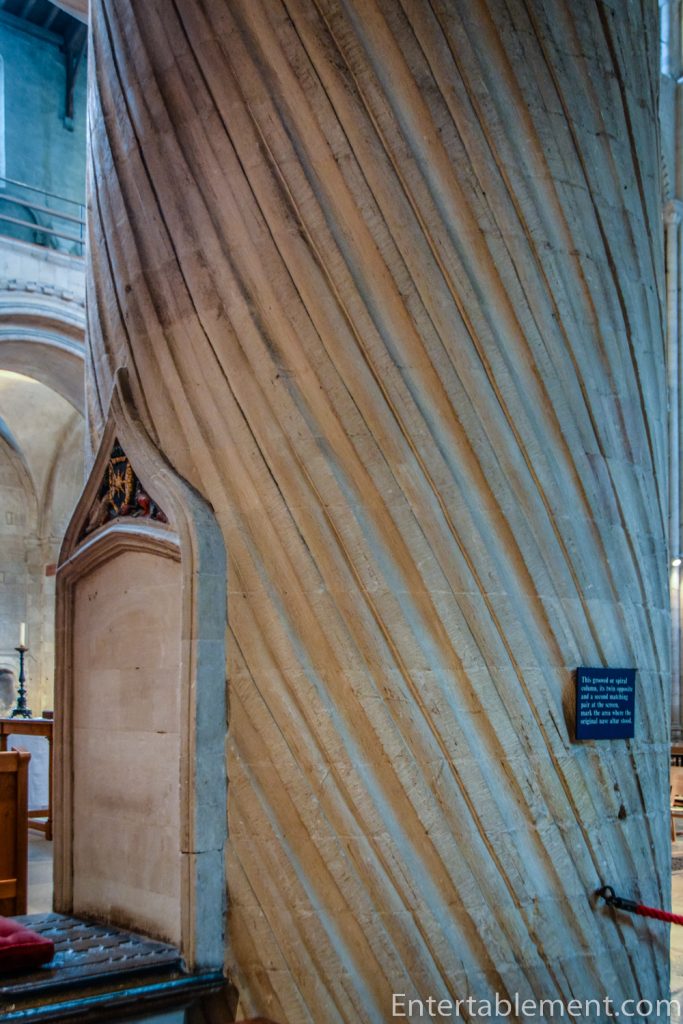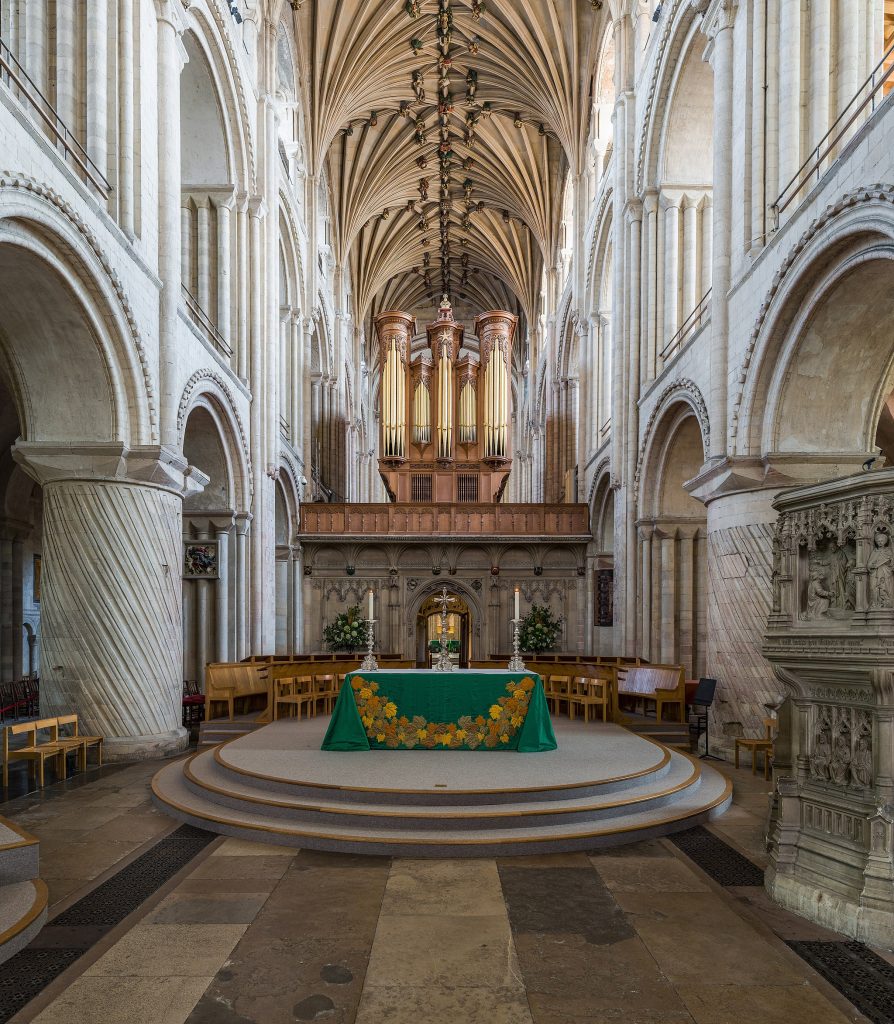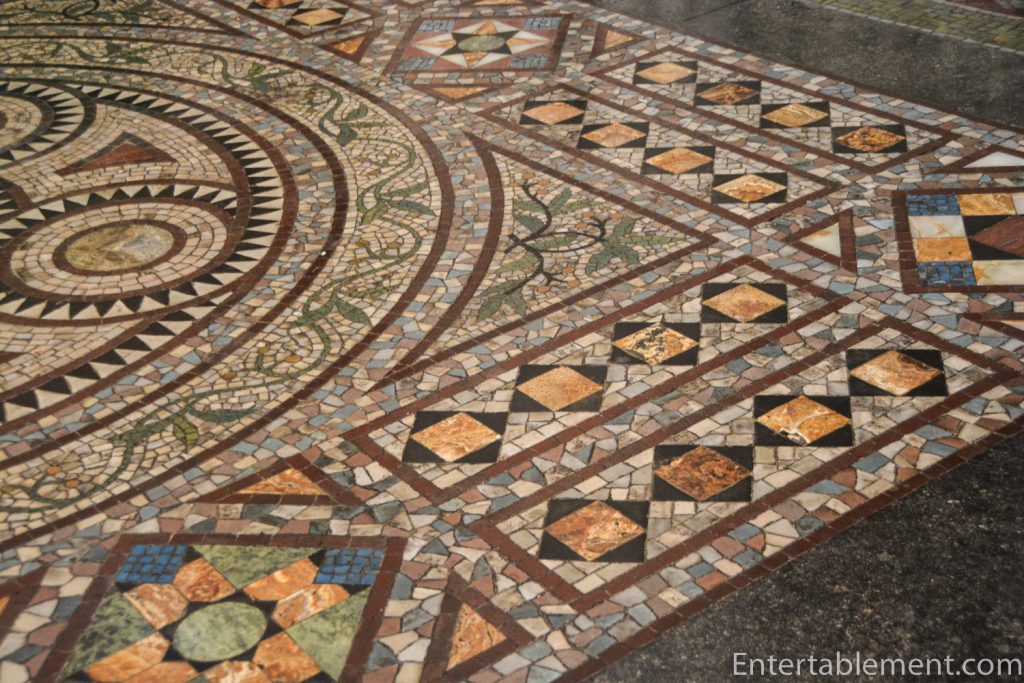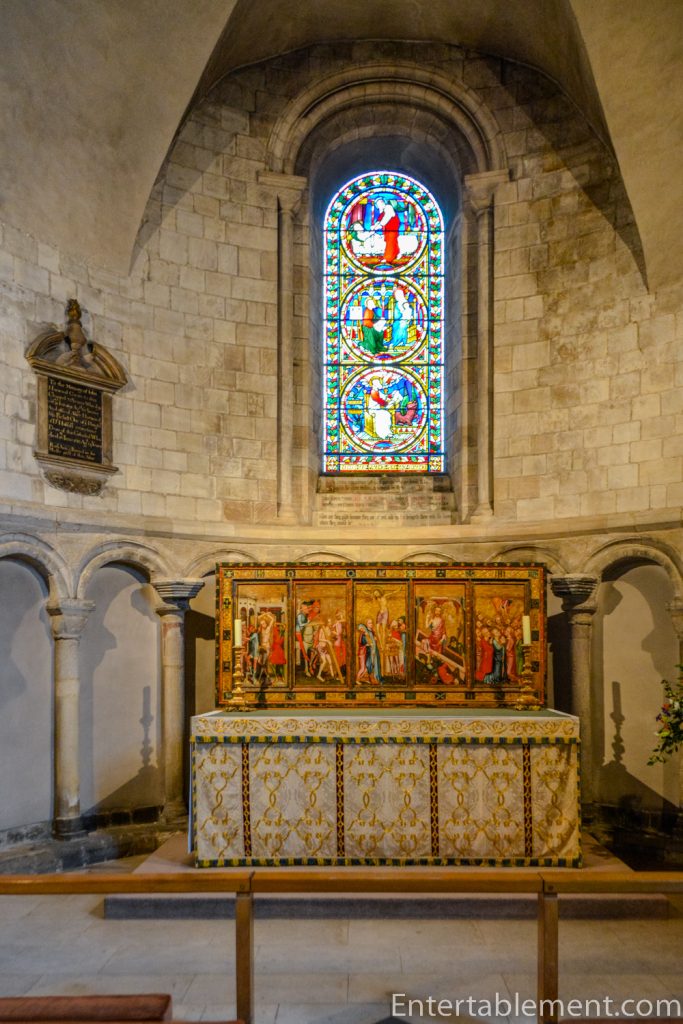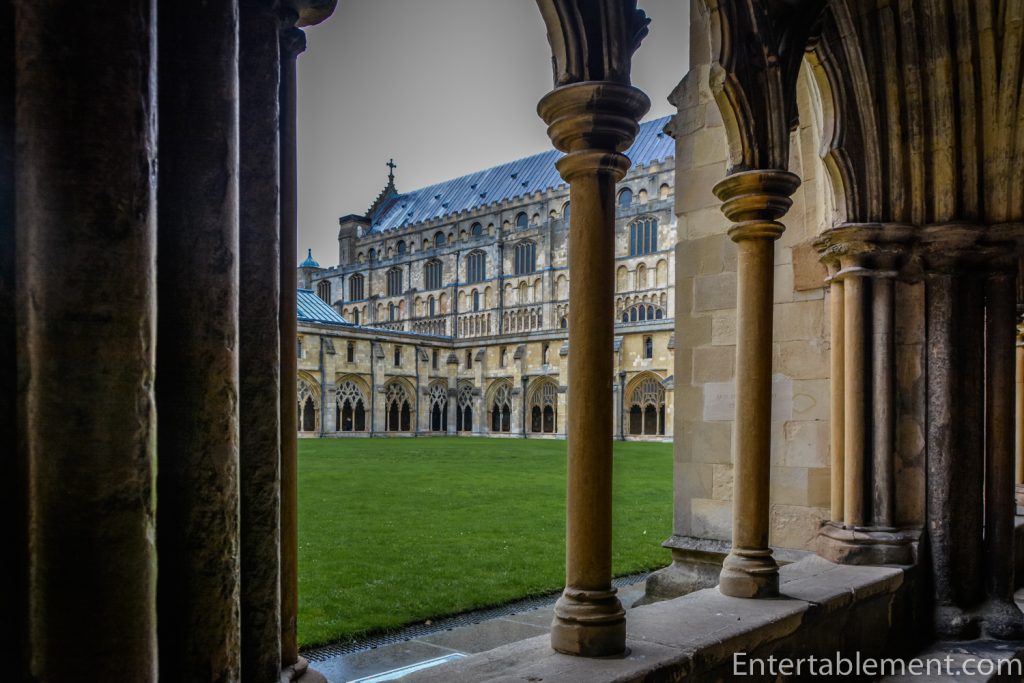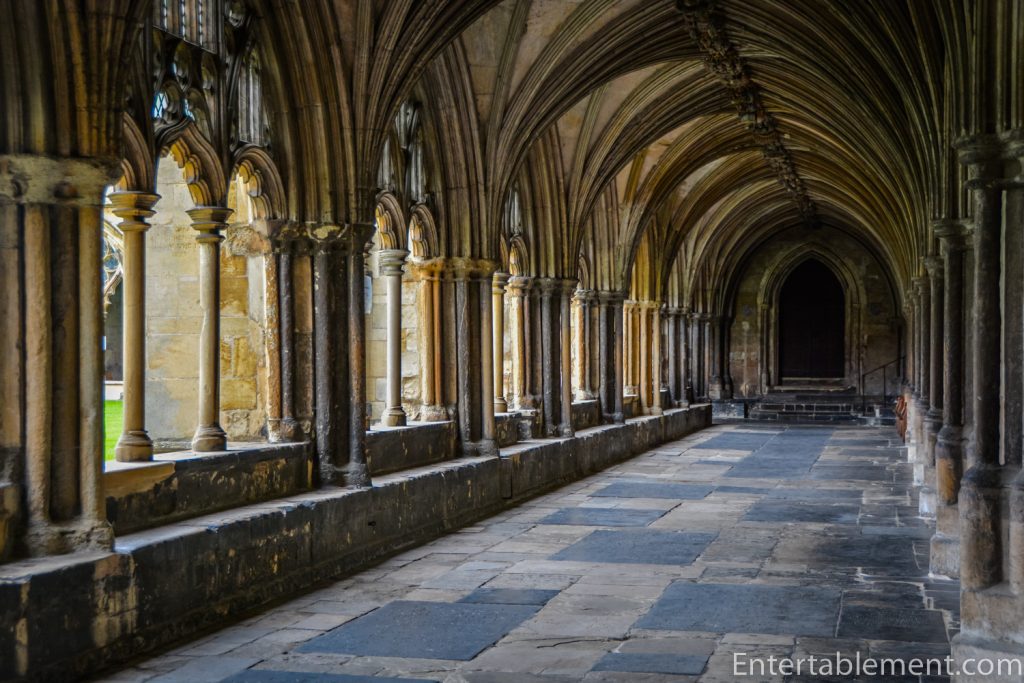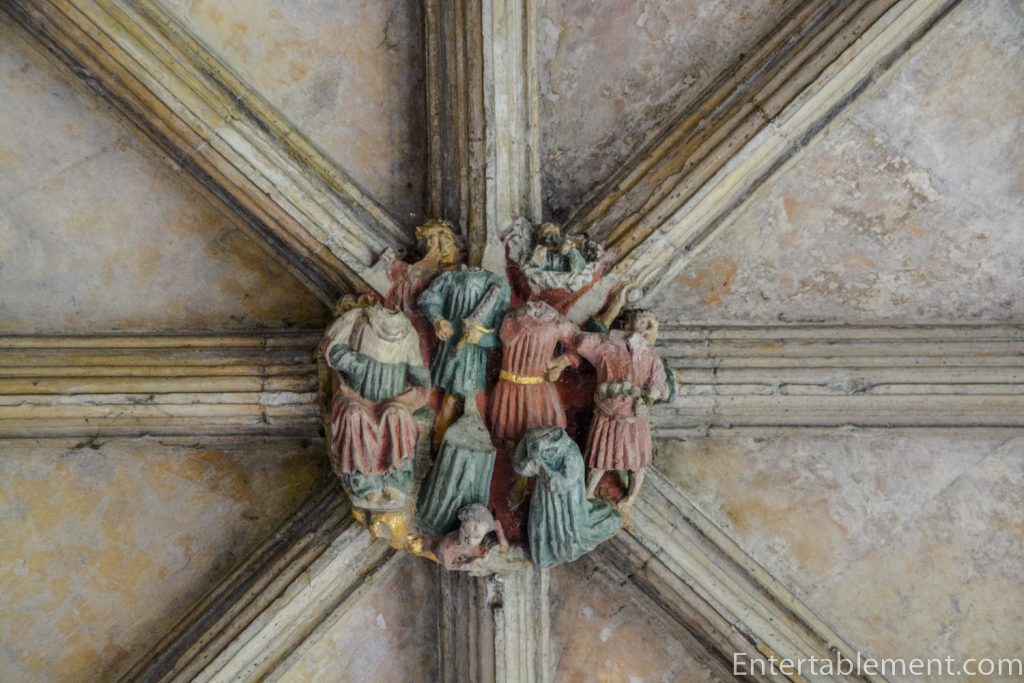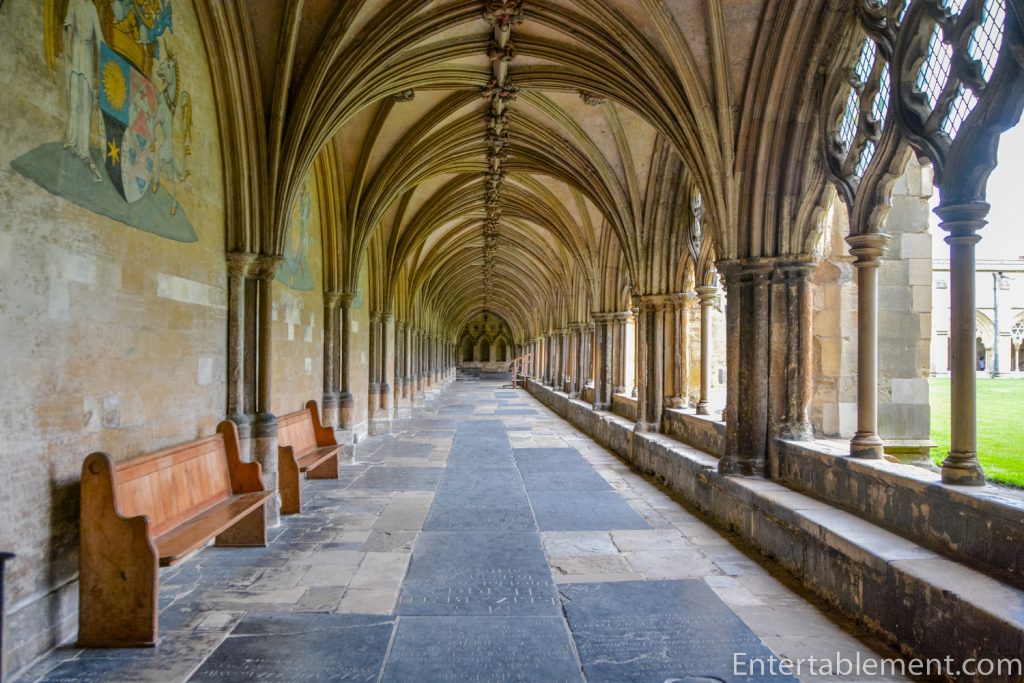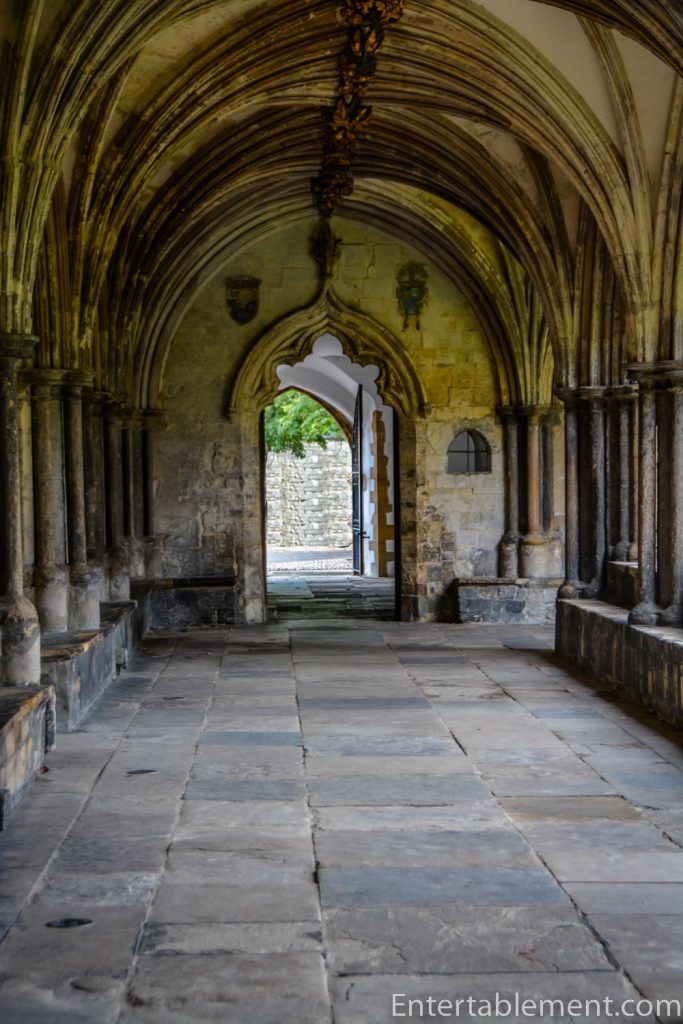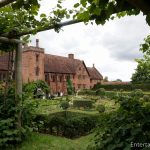Norwich Cathedral embodies the single-minded ambition of its first bishop, Herbert de Losinga. A controversial figure, our Herbert. He secured his position through bribery and displayed equal contempt for Norwich’s local citizenry, dispossessing and demolishing about a third of the Anglo-Danish town to build the Cathedral and its close.
The Cathedral’s website is circumspect about its founding bishop, saying, If Herbert was ambitious, he was also a devout and conscientious pastor who was lavishly generous with the funds available to him.
Lavish he certainly was. Bishop Losinga ensured that Norwich’s fourteen-bay nave exceeded Canterbury’s in length—it’s almost as long as Winchester’s. But it sure is pretty! Graceful pier shafts (ribbed columns) soar from ground to vault without interruption.
Begun in 1109 and completed around 1145, Norwich Cathedral was built all of a piece. And with ample funds available, it avoided subsequent eastern additions containing saintly relics to attract pilgrims—a coffer-swelling attraction routinely employed by cathedrals less fortunately endowed.
The crossing tower was the last piece of the Norman cathedral to be completed, c1140, and the highest of its contemporaries.
The current 315 ft stone spire was added in 1480, replacing the original wood covered with lead. The new spire is exceeded in height only by Salisbury’s, at 404 ft.
In the 15th century, a clerestory was added to the nave.
A stone vault replaced the original wood ceiling. Simon Jenkins of England’s Cathedrals describes Norwich as a “box of Norman walls with a graceful Perpendicular lid”—a very apt description.
Keystones are vital to the construction of a ribbed, vaulted ceiling.
The decorated bosses are the visible underside of the keystones (the pink block below),
Over two hundred decorated bosses stud the nave ceiling at Norwich, and these are only a fraction of the more than thousand that adorn the Cathedral and its cloisters.
Some feature flora and fauna, such as this one with tree-dwelling birds.
Others feature famous people from biblical histories, such as the one depicting the death of John the Baptist.
For a slightly more gruesome/comical note, the recently executed St Denis walks with his severed head to the church.
Looking back down the nave to the great Perpendicular west window. The North and South aisles retain their original flat wooden ceilings.
A modest memorial to Thomas Gooding, a mason of Norwich Cathedral who died in 1600, is in the south aisle of the nave. He insisted on being buried upright, believing it would speed his way to heaven during the ugly rush on Judgment Day.
Looking back towards the east, a stone rood screen separates the main part of the nave from the choir beyond.
The screen sits below the organ, with its archway leading to the choir.
The carved marble pulpit sits just to the right (south) of the doorway.
Somewhat unusually, the choir is west of the crossing, forming the westernmost part of the nave. It leaves a fairly short presbytery which terminates in a rounded apse, with a few chapels tacked onto its perimeter.
The rather garish chantry chapel of Bishop James Goldwell occupies the space between two bays in the south aisle of the choir. Can you spell o-s-t-e-n-t-a-c-i-o-u-s?
Rising above it are arches topped with decorative stonework crusted with diamond-shaped edging.
The underside of the arches is intricately carved.
Looking up into the underside of one of the arches, it’s dizzying to see the height of the heavily bossed vault above.
The canopies above the choir stalls are original, from the 15th century. The stalls themselves were designed by J. L. Pearson and installed in the 19th century as part of the Victorian restoration. They’re slightly paler in colour than the original wood.
J. L. Pearson also built the Bishop’s Chair.
As well as the choir pulpit.
Its most interesting feature is Budge, the Cathedral Cat. He wandered in one Good Friday and has been a frequent visitor ever since. Though he has a perfectly good home nearby, he’s frequently snoozing in the choir stalls, on one of the heat registers, or on the lectern of the pulpit. He has his own Instagram and Twitter accounts!
After the calm uniformity of the soaring pillars in the nave, it’s a bit startling to encounter the stubby twist-pattern Norman pillars flanking the Sanctuary. They’re massive.
Here we are, looking west, back towards the choir, with the organ soaring above. This perspective gives you a real sense of the pillars’ relative visual (and physical) weight, necessary due to the downward and outward thrust of the rounded Norman arches. Later, the engineering behind Gothic pointed arches changed the dynamics, making lighter, more slender pillars possible.
The marble mosaic tile floor of the Sanctuary is vividly coloured.
The Sanctuary terminates in the curved apse, beyond which are several chapels. This one is the Jesus Chapel,
And here we have St Luke’s Chapel.
Above the altar is the Despenser Retable, named after Henry le Despenser (1369–1406), who served as Bishop of Norwich, and whose forces successfully contained the Peasant’s Revolt of 1381. The piece was uncovered in 1847, having spent some time as the underside of a tabletop, likely hidden to prevent its destruction by Cromwell’s Parliamentary forces during the Civil War.
Let’s head out now to the cloisters, remarkable for their size (second only to Salisbury) and their excellent state of preservation. Note that they have two storeys, the only such example in England. They were built over an extended period, beginning in 1297 and finally finished in 1430.
Significantly, the architecture remained very similar throughout the extended construction, though some details, such as the tracery of the openings facing the cloister garth, did change.
The vaulted ceilings contain 400 carved stone ceiling bosses.
As you can see, the heads on these were much more accessible and susceptible to club-wielding iconoclasts during the Civil War.
The cloisters also contain the Prior’s Door, where seven colourful figures perch above a pointed arch—Christ in the centre flanked by Moses, St John the Baptist, St Edmund and attendant angels.
Back outside, let’s have one last look at Norwich Cathedral, the physical manifestation of Bishop Losinga’s indomitable will to leave his mark on the world. Its uniformity in design and intact survival is second only to Salisbury.


